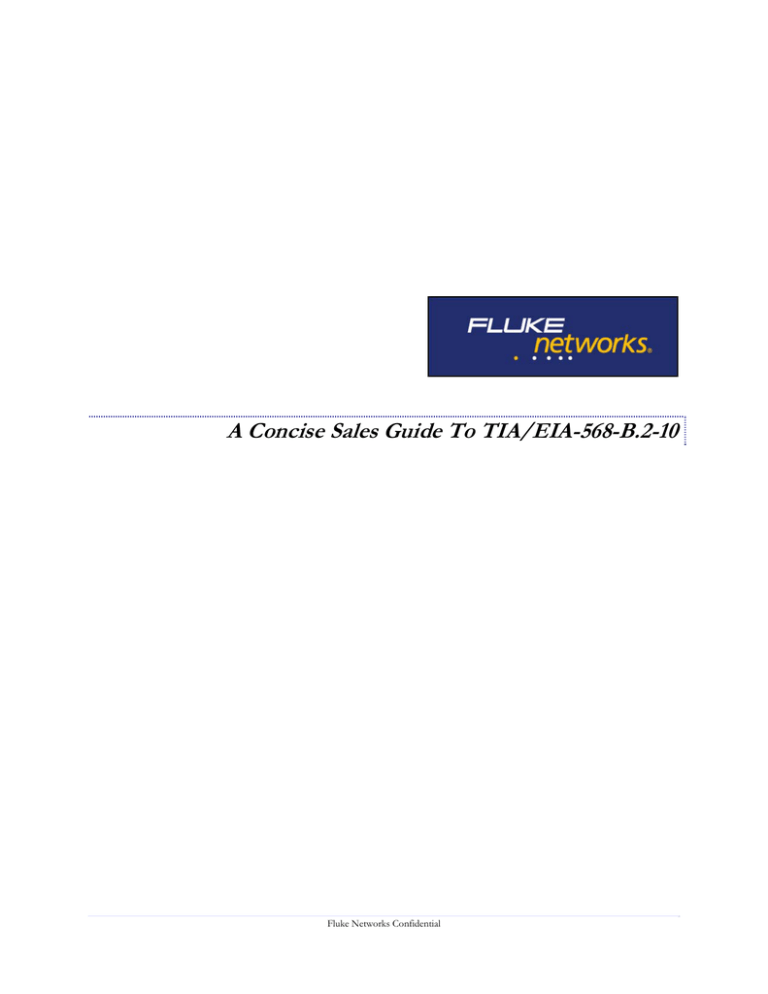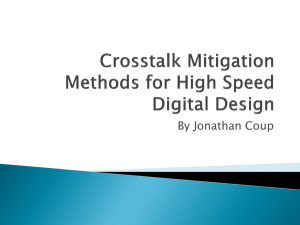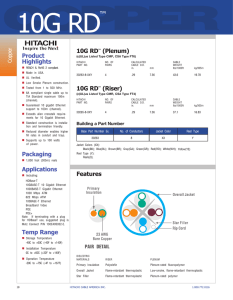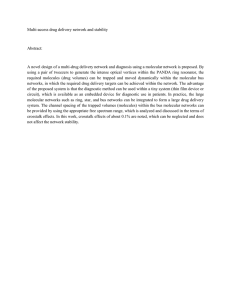A Concise Sales Guide To TIA/EIA-568-B.2-10
advertisement

A Concise Sales Guide To TIA/EIA-568-B.2-10 Fluke Networks Confidential Summary 10 Gigabit Ethernet is the root of Amendment 10 of the TIA/EIA-568-B.2 standard. Called “T568B-10” here for brevity, this standard documents how to run 10 Gbps Ethernet on up to 100 meters of twisted pair Category 6A cabling. Without T568-B-10, 10Gbps Ethernet would have been limited to shorter links or anchored to expensive Category 7 cable. With T568-B-10 and its clear standards for deployment and testing, 10Gbps Ethernet can thrive. Cabling installers can ride the Cat 6A or 10Gbps Ethernet wave, but to do so they must have the capability to test per the standard. T568-B-10 will drive cabling installers to upgrade their certification resources to remain competitive or grow. What is T568-B-10? The Telecommunications Industry Association (TIA) TR-42 technical committee defined and approved Augmented Category 6 (Cat 6A) cabling in Amendment 10 to the ANSI/TIA/EIA-568B.2 document in February, 2008. The standard is officially called TIA/EIA-568-B.2-10 but we use shorter nomenclature here. T568-B-10 has three important elements for Category 6A certification: 1. It renames some In-Channel test parameters and adds two new ones 2. It re-emphasizes the importance of the Permanent Link test model 3. It adds Alien Crosstalk measurement The test parameters for Cat 5e and Cat 6 cabling links remain the same, but a few were renamed. The table below shows the parameters, the abbreviations and where applicable the new name in bold. We refer to all of these as In-Channel parameters. Parameter – Former Name Parameter – New Name Insertion Loss (IL) Near End Crosstalk (NEXT) Power Sum Near End Crosstalk (PSNEXT) Insertion Loss (IL) Near End Crosstalk (NEXT) Power Sum Near End Crosstalk (PSNEXT) Attenuation to Crosstalk Ratio (ACR) Attenuation to Crosstalk Ratio – Near End (ACRN) Power Sum Attenuation to Crosstalk Ratio (PSACR) Power Sum Attenuation to Crosstalk Ratio – Near End (PSACRN) Far End Crosstalk (FEXT) Equal Level Far End Crosstalk (ELFEXT) Power Sum Equal Level Far End Crosstalk (PSELFEXT) Return Loss (RL) Wire Map Propagation Delay Delay Skew Length Far End Crosstalk (FEXT) Attenuation to Crosstalk Ratio – Far end (ACRF) Power Sum Attenuation to Crosstalk Ratio – Far End (PSACRF) Return Loss (RL) Wire Map Propagation Delay Delay Skew Length T568-B-10 stipulates that a certification tester must measure these parameters over the frequency range of 1 MHz through 500 MHz. The DTX-1800 has supported this range since 2004. Fluke Networks Confidential T568-B-10 added new parameters for 10Gbps Ethernet to characterize Alien Crosstalk. They are Power Sum Alien NEXT (PSANEXT) and Power Sum Alien Attenuation to Crosstalk Ratio from the Far-end (PSAACRF). The DTX-1800 with the Alien Crosstalk Kit measures both. The Permanent Link Test Model The Permanent Link model tests the cable infrastructure: cabling, end-jacks and terminations. Results from a Permanent Link test can apply to the life of a cabling system since the infrastructure remains largely static, except for major move and change projects. The Permanent Link Plugs The Permanent Link ends at the mated plug/jack at the patch panel and the Telecommunication Outlet. The test adapter and interface cable from the plug to the tester must be transparent to all measurements. Field certification using the Permanent Link model sets a crucial baseline by assuring that the installed cabling meets the performance specified by the standard. While the standard defines the performance of individual connector components (plugs and jacks) as well as their mated electrical performance, verifying individual component performance has been a challenge. To address this weakness Fluke Networks proposed a direct probing technique during the development of the Cat 6 standard. It was further refined during Cat 6A development. As a result of our work, the T568-B-10 standard references an 8-pin modular test plug for measuring NEXT, FEXT and Return Loss that uses a printed circuit board. Fluke Networks developed the reference plug that is depicted in the standards document, “Section G.3.9.2 Test plug construction for return loss testing – Fig G.11 Example of a test plug using PCB substrate.” The test plug cited by T568-B-10 is integral to the DTX-PLA002 Permanent Link Adaptor. The DTX-1800 is the only cable tester that has the adapter referenced in T568-B-10 standard. A Permanent Link Adapter made of commercial grade cable and plugs cannot assure that passing a Permanent Link test certifies component compliance. T568-B-10 safeguards backward compatibility. Certification with the centered Cat 6A test plug assures Cat 6 and Cat 5e component performance. The Channel Test Model The Channel model includes the patch cords plus the Permanent Link. You can certify that a Channel will support the transmission requirements at a given level (e.g., Cat 6 or Cat 6A) but if you Fluke Networks Confidential then exchange a patch cord, all bets are off. You cannot guarantee a replacement patch cord deliver the same mated performance as the original. Such is the nature of patch cords and the value of the Permanent Link model. The Channel model can be useful for troubleshooting. It may be useful for Certification if the patch cords employed in the test remain in-place for the network operation. This is rarely the case for initial Certification of cabling links. One final nuance: since the Permanent Link test certifies that end-jacks meet specifications, successfully passing this test guarantees that a Channel Test will pass if standard-compliant patch cords are used. This means that the Channel will not have to be re-certified, again as long as standard-compliant patch cords are used. The variability of patch cords is quite high, though, so a user should test them separately to assure compliance. Alien Crosstalk Testing Alien Crosstalk is signal coupling (crosstalk) between wire pairs within adjacent cables. Alien Crosstalk increases at the higher frequencies used for 10Gbps. While the electronics of 10Gbps Ethernet uses techniques to improve in-channel performance for NEXT and Return Loss, it is unaware of signaling from outside the cable. This means it cannot perform mitigation, cancel crosstalk or improve performance against an Alien Crosstalk noise source. The cabling system, and only the cabling system, must overcome Alien Crosstalk to deliver reliable, error-free transmission. Many cabling manufacturers evaluate the Alien Crosstalk performance of their products in their labs. This is valuable, but lab tests cannot certify installer workmanship. Only field certification guarantees that the installation meets standards in real-world conditions. Certifying Cat 6A for 10Gbps: Two Phases The process for certifying Cat 6A for 10Gbps Ethernet has two components. Phase One: Complete test of every Permanent Link Test the In-Channel parameters listed in the table on page one for every Permanent Link. Phase Two: Sample-test links for Alien Crosstalk Sample test cables within a bundle for Alien Crosstalk, selecting those links most prone to Alien Crosstalk Testing every link for Alien Crosstalk is unnecessary. Channel under test Synchronization Link Termination Plugs All evidence shows that cables in different bundles do not interact with each other, even when the bundles are no more than an inch apart. Fluke Networks Confidential A test methodology and the sampling technique are described in the Fluke Networks whitepaper, “How to Certify or Re-certify Twisted-Pair Cabling for 10 Gbps Ethernet.” Test recommendations apply to shielded as well as unshielded cable. Damage, corrosion and workmanship all can undermine the effectiveness of shielding The Alien Crosstalk test delivers a very good measure of shield effectiveness whereas an in-channel wiremap test only verifies the DC continuity of the shield. Wrap-Up: Four Things to Remember About T-568-B-10 1. T568-B-10 is now a real, accepted standard. 2. Only the Fluke Networks’ Permanent Link Adapter has a reference test plug. This plug is shown in the T568-B-10 standard as the example test reference plug. Other tester manufacturers use off-the-shelve cords and plugs for Permanent Link Adapters, diminishing the value of their tests. 3. Permanent Link testing is not just an option- it is necessary for 10Gbps applications. 4. Alien Crosstalk testing may appear complex, but it is performed on a sample basis that reduces the amount of time consumed. Fluke Networks Confidential





